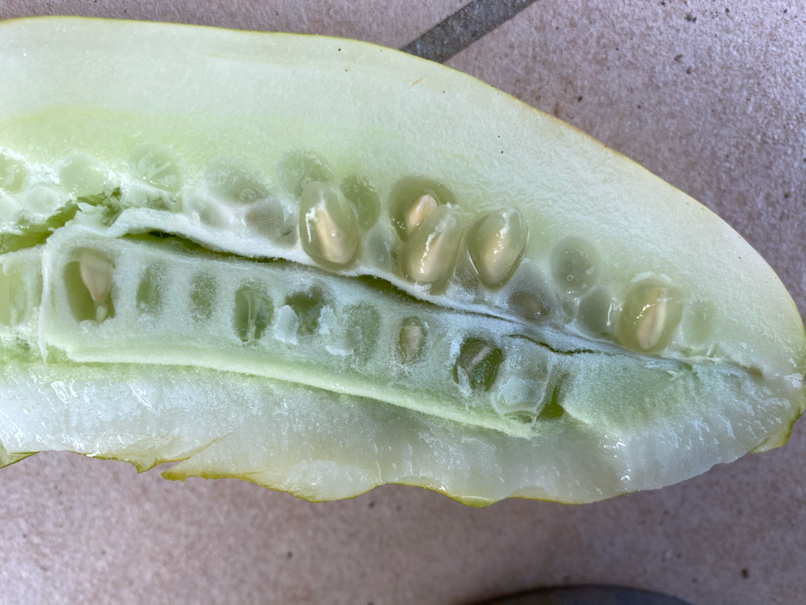Carefully slice open the cucumber without damaging the seeds. When I opened it, I was surprised to find that despite its large size, the cucumber had very few seeds.
Cucumbers can set fruit without pollination, but they also easily cross-pollinate with other plants.
While the presence of seeds indicates some level of pollination, the number of seeds seems quite low, doesn’t it?

This section of cucumber is completely empty, with no seeds at all. Where did the seeds that were supposed to develop in this hollow go?

This part also has noticeable empty sections, but there are some seeds. Scoop out the cucumber seeds and collect them in a sieve.
Remove the gel-like part surrounding the cucumber seeds and dry them

Even though the cucumber was so large, there were only this many seeds.
There are about three methods to remove the gel-like part surrounding the seeds.
- Place them in a plastic bag for 2-3 days to allow the gel-like substance to decay, then extract only the seeds
- Rinse the gel-like substance off with water
- Extract the seeds onto kitchen paper and remove the gel-like substance
The first method seems to be the most popular based on what I’ve seen online.
Indeed, leaving tomatoes or similar fruits with the gel-like substance for a few days makes seed extraction easier.
For beginners, I would recommend the first method.
As for the second method, rinsing the gel-like substance off with water, it’s worth noting that this substance contains germination-inhibiting compounds.
Adding water to remove this compound may not be advisable, as it could promote germination prematurely.
While it’s understandable why it’s not recommended to encourage germination right after seed extraction, personally, I feel a bit less cautious might be okay, as the seeds will soon be dried, preventing excess moisture for germination.
The third method is recommended for cases like this one, where there are few seeds.

So, rub the gel-like substance onto kitchen paper to separate it.
It’s easy when there are just a few seeds like this, but if you have a large quantity, it’s nothing but a hassle, so I wouldn’t recommend it.
Select the cucumber seeds that have sunk in water and allow them to dry

Once you’ve removed the gel-like substance, soak the seeds in water briefly for sorting.
For cucumbers, good seeds tend to sink in water. As for zucchinis, it seems that the good seeds float, but this difference may not be obvious to amateurs.
Seeds with empty interiors tend to float, making them unsuitable for seed saving, so discard them. Upon soaking, approximately 50% of the seeds floated.
Arrange the sorted cucumber seeds on top of a piece of kitchen paper and let them dry

Once you’ve gathered the sunken cucumber seeds, lay them out on a piece of kitchen paper to dry, and your seed extraction process is complete.
In the end, out of the large cucumber, I was only able to gather 16 seeds that seem suitable for next year’s use. It’s astonishing that I could only obtain this few seeds from such a large cucumber…
I was able to secure over 80 seeds by extracting seeds from two more cucumbers. Although they may result in F2 seeds, it looks like I’ll still be able to enjoy cucumbers next year.
Let’s collect cucumber seeds for next year’s cultivation
This time, I introduced a method for collecting seeds from ripe cucumbers for next year’s use.
Collecting cucumber seeds itself isn’t difficult; you just need to let the cucumbers ripen until they turn yellow. However, having large cucumbers doesn’t necessarily mean you’ll get a lot of seeds. Even after collecting seeds from three cucumbers, I only managed to get around 80 seeds.
The seeds from the second and third cucumbers were plentiful, but most of them floated and were unusable.
Still, 80 seeds should be sufficient for several years, so it’s quite convenient. Since next year’s seeds will be F2 generation, the growth may vary, so it’s wise to sow a bit more and observe the results.
Why not try collecting cucumber seeds for next year’s cultivation?














コメント